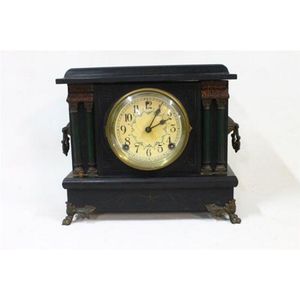Ansonia Black Slate Eagle Mantle Clock
You must be a subscriber, and be logged in to view price and dealer details.
Subscribe Now to view actual auction price for this item
When you subscribe, you have the option of setting the currency in which to display prices to $Au, $US, $NZ or Stg.
- Pendulum - The pendulum was discovered around 1602 by Galileo Galilei, and was adopted for time keeping by the Dutch mathematician and natural philosopher, Christiaan Huygens, who excelled in astronomy, physics, and horology.
The pendulum comprises a metal rod usually of brass or steel with a metal disk, known as a bob, at the end. The movement of the pendulum is driven by weights or a spring, and as a pendulum swings in a regular arc, it was found accuracy could be controlled to within a few seconds a week.
Timekeeping can be adjusted by changing the height of the bob on the rod, making the pendulum either swing slower or faster.
The disadvantage of the pendulum was that changes in temperature also changed the length of the pendulum, interfering with the accuracy of the clock, and so in the 18th century two types of mercurial pendulums were invented which countered the movement in the steel rod.
The pendulum was the world's most accurate timekeeping technology until the invention of the quartz clock, regulated by a quartz crystal, in 1927. - The Eagle - The eagle has been a symbol of power, victory, and strength for centuries. It is often associated with bravery, prowess, and dominance, and has been used as a symbol by many cultures and civilizations throughout history.
In ancient Greece, the eagle was associated with the god Zeus, who was considered the king of the gods and the ruler of the skies. In many cultures, the eagle was seen as a messenger between the physical world and the spirit world, and was associated with the sun and the sky.
In the Roman Empire, the eagle was the symbol of the Roman army, and was displayed on the standards of the soldiers to show the power and authority of the empire. In medieval Europe, the eagle was used as a symbol of power and victory by monarchs and rulers, and was often depicted in art and architecture as a symbol of strength and courage.
In modern times, the eagle continues to be a symbol of power, victory, and strength. It is often used as a symbol by nations and organisations, and is frequently depicted in art and on monuments to commemorate important events and achievements.
The eagle's powerful appearance, combined with its association with freedom, courage, and dominance, makes it a popular and enduring symbol of power and victory.
This item has been included into following indexes:
- Ansonia (United States) - clocks, maker or retailer 316
-
clocks, material or decoration
- marble or slate, black 342
- slate 344
Visually similar items

A black metal mantle clock, with gilt dial by A. Saunders, Sydney, with key and pendulum.

An American mantle clock by 'the Sessions clock Co., enamel dial with arabic numerals, brass outer rim, eight day time & strike movement, enameled wood case with marbalised mouldings & cast bronze detail, with winding key, 27.5 x 32 x 14 cm

A French black marble mantel clock with urn decoration, 40 cm high, 24 cm wide, 14 cm deep

A Georgian IV mahogany bracket clock, maker Fisher, Bath, with a twin fusee movement and pull repeat, the arched top over a white painted dial with Roman numerals signed Fisher Bath, below applied foliate on bun brass feet. 55 cm high, 31 cm wide 18 cm dee
